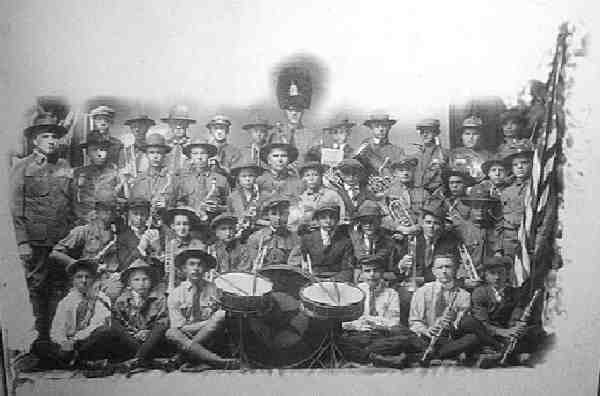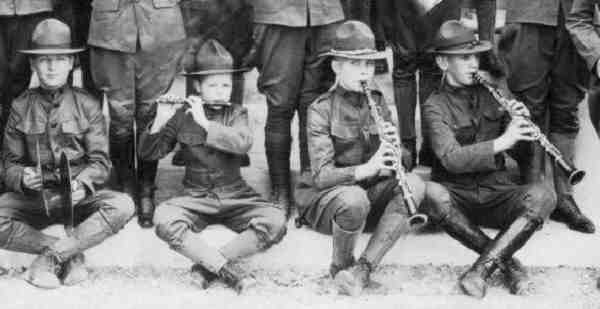
Figure 1.--This early American Scout band was photographed in the 1910s. There does not appear to be any special band uniform.


Figure 1.--This early American Scout band was photographed in the 1910s. There does not appear to be any special band uniform. |
American Scout groups formed bands in the 1910s, 1920s, and 30s. They appear to have been formed out of smaller drum and buggle corps. Some of the bands were quite large. I'm not sure whether this was following the British example or not. Probably school bands were not as common at the time as they are now. In more recent years I have noted only a hanful of Scout bands. American Scout bands even when they did exist did not have band competitions like English Scouts. Many U.S. Scout units, however, have drum and bugle corps.
American Scout groups formed bands in the 1910s and 1920s, apparenttly following the European or at least British pattern. Some were quite large and appear to have been serious efforts. I'm not sure at what kind of events they played at, but they must have performed at some non-Scout events. There does not seem to have been any specialized uniform items for these bands. Scout bands appear to decline in popularity during the 1930s. There appear to have been few if any Scout bands by the 1940s. In more recent years HBU has not noted Scout bands. Many U.S. Scout units, however, have continued to maintain drum and bugle corps.

Figure 2.--HBU believes that Scout bands declined in popularity, in part, because so many boys wanted to participate in school marching bands. |
HBU is not sure why Scout bands declined in popularity in the United Stastes. We suspect that most potential participants probably preferre to participate in the bands that high schools promoted. Football is a major part of the American high school experience, bith for the players and the whole student body who attended the games. The band of course was a major part of the pagentry. European schools had nothing quite like this. Scouting had nothing to rival this. American Scout bands even when they did exist did not have band competitions like English Scouts.
I am not sure what the inspiration for American Scout bands. That appeared to have developed out of drum and buggle corps organized by eaely Scout groups. I have no solid evidence yet, but rather suspect it was inspired by English Scouts organizing bands rather than American Scouts conceiving the idea on their own. Probably school bands were not as common at the time as they are now.
Scout bands do not appear particularly popular. Rather boys seem much more interested in participating in their school bands, especially the marching bands performinh at fooball halftimes and other events.

Figure 2.--American Scouts no longer have formal bands, but like this troop in the 1990s, often have drum and bugle units. |
While there are not many American Scout bands, there are a few. The Marblehead All Scout Band for example is on current Scout bands. Members include Girl Scouts and Cub Scouts. The Indianapolis Croosroads Scout Band was founded in 1917 and still exists.
The Crossroads of America Scout Band is recognized as the OLDEST, continuously operating Scout Band in America. I'm not sure if English or other foreign bands predate it. It was founded as a Drum and Bugle Corps in 1917 by Mr. F.O. "Chief" Belzer to play at ceremonies at summer camp and other council functions, the organization evolved into a full band by the early 1920's. The band has a rich heritage and has toured throughout North America (and Canada). There have been as many as 200 members in the band at a single time, and they were once known as "Scouting's Marching 100" as they marched the streets of Indianapolis in parades. Accomplishments and noteworthy events of the band include:
Participation in EVERY National Scout Jamboree since 1950
Participation in EVERY Indianapolis 500 Festival Parade from 1957-1992
Performed for four U.S. Presidents (Truman, Eisenhower, Johnson and
Nixon)
Performed for the Queen of England
Appeared with movie director, Cecil B. DeMills on CBS from the
Barnum Circus Festival in Bridgeport, Connecticut.
Performed at three World Fairs (New York twice and Knoxville,
Tennessee)
Maintains a high percentage of Scouts earning the rank of Eagle Scout
Performed for Maria Von Trapp at the Von Trapp Lodge in Stowe, Vermont
Performed at the US Capitol Building.
Served as band for National Order of the Arrow Conferences for 30+ Years.
They are now building towards the 100th anniversary of the band in the year 2017.
The American Scout bands established in the 1900s and 1910s do not appear to have had any special uniforms. The few Scout bands they exist today do not appear to give an real attention to uniform.
Navigate the Historic Boys' Uniform Chronology Pages:
[Return to the Main chronologies page]
[The 1900s]
[The 1910s]
[The 1920s]
[The 1930s]
[The 1940s]
[The 1950s]
[The 1960s]
[The 1970s]
[The 1980s]
[The 1990s]
[The 2000s]
Navigate the Historic Boys' Uniform Web Site:
[Introduction]
[Chronologies]
[Organizations]
[FAQs]
[Bibliographies]
[Contributions]
[Boys' Uniform Home]
Navigate the Historic Boys' Uniform Web organizatiion pages:
[Return to the Main Scoutband page]
[Boys' Brigade]
[Camp Fire]
[Hitler Youth]
[National]
[Pioneers]
[Royal Rangers]
[Scout]
